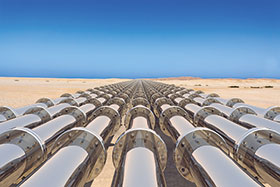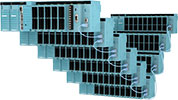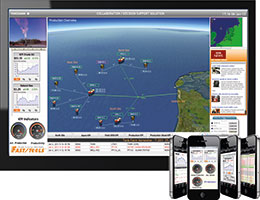

Yokogawa’s unique portfolio for best-in-class scada solutions comprises of the versatile Stardom network-based control system (NCS), and the FAST/TOOLS supervisory HMI software platform. This solution is deployed in applications across various industries, particularly when highly distributed network architectures will be required.
Applications like pipeline networks, telemetry infrastructure for remote pumping stations and low bandwidth networks with intermittent communication characteristics are no challenge for the platform. Besides such typical applications in the energy and water utilities supply chains, Yokogawa’s scada solutions are also suitable for typical process and factory automation applications. The system is flexible and scalable from a small footprint to large network architectures and capacities. The Stardom controllers, in combination with the FAST/TOOLS software, provide an extremely cost effective investment to achieve ‘Excellent scalability and Excellent reliability’ (the ‘E2 Concept’). It is the ideal combination of the reliability of a DCS, coupled with the versatility and economy of a PLC/RTU-based system.
Open network-based control
Stardom is an open network-based control system consisting of a field control node (FCN) autonomous controller with highly flexible I/Os and communication capabilities. It offers robust features where all core components (power supply, CPU, I/O rack communication and the control network) can be easily implemented in a dual redundant configuration, thus providing continuous high availability.

Yokogawa’s continuous investment in the Stardom FCN has produced the new ‘E2’ bus interface module, which enables up to eight I/O units to be connected to the FCN-500 control unit, thereby tripling the maximum number of allowable I/O points. In addition, the maximum possible transmission distance between individual units has been increased to 100 metres. Therefore, with a nine-unit configuration, the maximum transmission distance is 800 metres; 100 times further than was previously possible. Using commercial off the shelf fibre optic cables and media converters, a Stardom system spanning several hundreds of kilometres, can be constructed. The use of remote extension units near sensors reduces wiring costs and maintenance workload.
Remotely distributed units are easily maintained during operations using diagnostic features like module status indications and capability to hot swap modules. Remote diagnostics enable the system to detect any malfunctions. Field maintenance is facilitated by the simple use of a standard web browser. Stardom supports the following communication protocols: HART, Modbus, DNP3, Profibus, Foundation Fieldbus and ISA100. In addition, Ethernet is supported, as well as legacy protocols such as serial communications.
The Stardom model range includes the option of an intelligent RTU, which is used for applications that require communications over long distances such as oil and gas wells, large pipeline networks or any project requiring control and monitoring of remote sites. There is also a flexibility to select a low power consumption model with compact footprint, ideal for solar powering at locations where utility power sources are not available.
Enterprise automation environment

Since 1978, Yokogawa’s FAST/TOOLS has evolved from a central host scada and HMI software to a distributed enterprise automation environment. This web-based real-time operations management, historian and visualisation software package, allows for real-time monitoring, alarm management, information intelligence and supervisory control. The key concept behind the design and development of the software is to connect sensors, devices, and plant facilities to enable the remote access of data and allow global supervisory control from authorised 24/7 operator stations, web-clients, tablets and smartphones. The FAST/TOOLS enterprise automation platform offers a comprehensive solution for the deployment, operation and monitoring of production and utility assets. This benefits customers by enabling faster decision-making, realising a reduction in total cost of ownership, and achieving operational excellence.
FAST/TOOLS has a master enterprise engineering database which is a central engineering environment containing all common enterprise definitions and deployment data. It has an open, event driven system architecture with web services technology. The software architecture scales from small deployments of a few hundred points to more than 10 million points to better match the demands of large enterprise topologies. A fully redundant disaster recovery concept is supported by triple or quadruple server clusters. The software suite also provides a high-performance process historian with production history archiving and retrieval. A web information service dramatically simplifies the delivery of operational information.
By combining the application security with hardened systems in a well-designed network architecture, FAST/TOOLS offers a robust scada solution whilst mitigating security vulnerabilities. It is a platform-independent software environment which is supported on Windows, Unix and Linux based operating systems. Virtualisation is supported across platforms thus separating the operating system (OS) from the hardware. A modern open scada platform should be able to bridge the legacy gaps between the IT and OT domains by leveraging OPC Unified Architecture (OPC UA), extensible mark-up language (XML) and direct database interfaces.
The support of the OPC UA enables the construction of simple and effective solutions for users who need to communicate with upper layer management systems. OPC UA is the latest version of the OPC standard, and it features a cohesive, secure, and reliable cross-platform framework for access to real-time and historical data and events.
The FAST/TOOLS server centric architecture allows clients to be deployed to any HTML5 compliant web-browser. Hence, users automatically receive the most recent version of an application and there is no need to manage licences and software installations on the client side. The platform can utilise any communication media for connection to other servers, applications or devices. LAN/WAN, serial, radio, microwave, satellite, fibre and many others are supported and can be simultaneously used within a single environment.
A fully integrated alarm system performance analysis (ASPA) function supports the alarm system performance improvement processes to avoid operator overload. This reduces the risk of critical alarms being missed, and therefore causing incorrect or delayed decisions. The system ensures safety as well as 24/7 production continuity and quality.
Cross industry adoption
GAIL is India’s flagship natural gas company, integrating all parts of the natural gas value chain including exploration, production, processing, transmission, distribution, marketing and services. GAIL has built two major liquefied petroleum gas (LPG) distribution networks on the Jamnagar Loni LPG pipeline and the Vizag Secundrabad LPG pipeline, which transport gas to bottling plants. The company deployed Yokogawa’s network control system to manage this pipeline network.
PowerSeraya in Singapore built a desalination plant that converts seawater into drinking and service water for the existing boiler plants and utilities. All operations at this plant are monitored and controlled by an integrated Stardom system, which has proven to be highly reliable.
The Petanu Water Treatment Plant in Indonesia was commissioned by the Ministry of Public Works and Housing to satisfy the growing water needs of the tourism industry on Bali’s south-east coast. The plant started its commercial operation in May 2014 and produces 300 litres per second of drinking water. Yokogawa’s system was selected as a one stop solution to meet these urgent market demands.
Conclusion
Recognising that most enterprises will take a hybrid approach in their management and control solutions, Yokogawa continues to pursue innovation in its key offering of Stardom and FAST/TOOLS for scada systems, which will ensure that customers are able to transform their data into meaningful information and maximise their return on investment.
For more information contact Christie Cronje, Yokogawa South Africa, +27 (0)11 831 6300, christie.cronje@za.yokogawa.com, www.yokogawa.com/za
| Tel: | +27 11 831 6300 |
| Fax: | +27 11 86 411 8144 |
| Email: | yma.info-za@yokogawa.com |
| www: | www.yokogawa.com/za |
| Articles: | More information and articles about Yokogawa South Africa |
© Technews Publishing (Pty) Ltd | All Rights Reserved